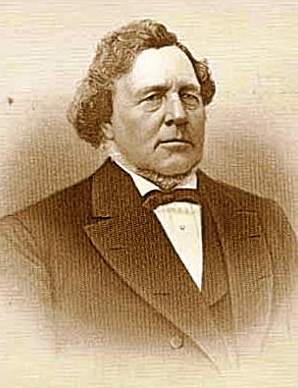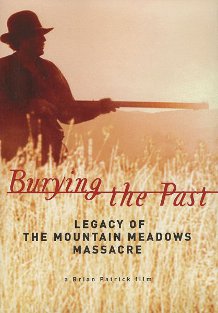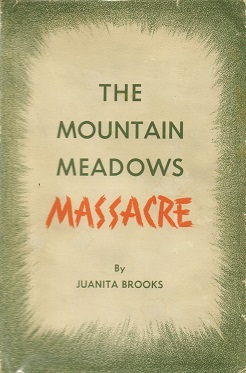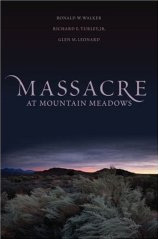
The Mountain Meadows Massacre was a series of attacks during the Utah War that resulted in the mass murder of at least 120 members of the Baker–Fancher emigrant wagon train. The massacre occurred in the southern Utah Territory at Mountain Meadows, and was perpetrated by settlers from the Church of Jesus Christ of Latter-day Saints involved with the Utah Territorial Militia who recruited and were aided by some Southern Paiute Native Americans. The wagon train, made up mostly of families from Arkansas, was bound for California, traveling on the Old Spanish Trail that passed through the Territory.

John Doyle Lee was an American pioneer, and prominent early member of the Latter Day Saint Movement in Utah. Lee was later convicted of mass murder for his complicity in the 1857 Mountain Meadows Massacre and sentenced to death. In 1877, he was executed by firing squad at the site of the massacre.

George Albert Smith was an early leader in the Latter Day Saint movement. He served in the Quorum of the Twelve Apostles and as a member of the First Presidency of the Church of Jesus Christ of Latter-day Saints.

Anton Alfred Newcombe is an American singer, songwriter, multi-instrumentalist, producer, and founder of the music group The Brian Jonestown Massacre.

The Ahatovići massacre was the mass killing of 47 captured Bosniak soldiers from the town of Ahatovići, in the municipality of Novi Grad, Sarajevo by the Army of Republika Srpska during the Bosnian War.

September Dawn is a 2007 Canadian-American Western film directed by Christopher Cain, telling a fictional love story against a controversial historical interpretation of the 1857 Mountain Meadows massacre. Written by Cain and Carole Whang Schutter, the film was a critical failure and box office disappointment.

The Yana are a group of Native Americans indigenous to Northern California in the central Sierra Nevada, on the western side of the range. Their lands, prior to encroachment by white settlers, bordered the Pit and Feather rivers. They were nearly destroyed during the California genocide in the latter half of the 19th century. The Central and Southern Yana continue to live in California as members of Redding Rancheria.

The Baker–Fancher party was a group of American western emigrants from Marion, Crawford, Carroll, and Johnson counties in Arkansas, who departed Carroll County in April 1857 and "were attacked by the Mormons near the rim of the Great Basin, and about fifty miles from Cedar City, in Utah Territory, and that all of the emigrants, with the exception of 17 children, were then and there massacred and murdered" in the Mountain Meadows massacre. Sources estimate that between 120 and 140 men, women and children were killed on September 11, 1857, at Mountain Meadows, a rest stop on the Old Spanish Trail, in the Utah Territory. Some children of up to six years old were taken in by the Mormon families in Southern Utah, presumably because they had been judged to be too young to tell others about the massacre.
The Mormons is a four-hour PBS documentary about the Church of Jesus Christ of Latter-day Saints. The production originally aired in two-hour segments on April 30 and May 1, 2007. It was produced by Helen Whitney, and was the first joint production of Frontline and American Experience.
Although the Mountain Meadows massacre was covered to some extent in the media during the 1850s, its first period of intense nationwide publicity began around 1872. This was after investigators obtained the confession of Philip Klingensmith, a Mormon bishop at the time of the massacre and a private in the Utah militia. National newspapers also covered the John D. Lee trials closely from 1874 to 1876, and his execution in 1877 was widely publicized. The first detailed work using modern historical methods was published in 1950, and the massacre has been the subject of several historical works since that time.
Mormon public relations have evolved with respect to the Mountain Meadows Massacre since it occurred on September 11, 1857. After a period of official public silence concerning the massacre, and denials of any Mormon involvement, The Church of Jesus Christ of Latter-day Saints took action in 1872 to excommunicate some of the participants for their role in the massacre. Since then, the LDS Church has consistently condemned the massacre, though acknowledging involvement by some local Mormon leaders.

Burying the Past: Legacy of the Mountain Meadows Massacre is a 2004 documentary film about the Mountain Meadows massacre. It was directed by Brian Patrick and has won 11 awards, but the producers were unable to obtain theatrical release for the film.
The conspiracy and siege of the Mountain Meadows Massacre was initially planned by its Mormon perpetrators to be a short "Indian" attack, against the Baker–Fancher party. But the planned attack was repulsed and soon turned into a siege, which later culminated in the massacre of the remaining emigrants, on September 11, 1857.

There have been several remembrances of the Mountain Meadows Massacre including commemorative observances, the building of monuments and markers, and the creation of associations and other groups to help promote the massacre's history and ensure protection of the massacre site and grave sites.
The Mountain Meadows massacre was a series of attacks on the Baker–Fancher emigrant wagon train, at Mountain Meadows in southern Utah. The attacks culminated on September 11, 1857, in the mass slaughter of the emigrant party by the Iron County district of the Utah Territorial Militia and some local Indians.

The Mountain Meadows Massacre (1950) by Juanita Brooks was the first definitive study of the Mountain Meadows Massacre.

Massacre at Mountain Meadows is a book by Latter-day Saint historian Richard E. Turley, Jr. and two Brigham Young University professors of history, Ronald W. Walker and Glen M. Leonard. Leonard was also the director of the Museum of Church History and Art in Salt Lake City, Utah. The book concerns the 1857 Mountain Meadows Massacre in southern Utah, and is the latest study of the subject.
In 1857, at the time of the Mountain Meadows Massacre, Brigham Young, was serving as President of the Church of Jesus Christ of Latter-day Saints and as Governor of Utah Territory. He was replaced as governor the following year by Alfred Cumming. Evidence as to whether or not Young ordered the attack on the migrant column is conflicted. Historians still debate the autonomy and precise roles of local Cedar City LDS Church officials in ordering the massacre and Young's concealing of evidence in its aftermath. Young's use of inflammatory and violent language in response to a federal expedition to the territory added to the tense atmosphere at the time of the attack. After the massacre, Young stated in public forums that God had taken vengeance on the Baker–Fancher party. It is unclear whether Young held this view because of a possible belief that this specific group posed a threat to colonists or that they were responsible for past crimes against Mormons. According to historian William P. MacKinnon, "After the war, Buchanan implied that face-to-face communications with Brigham Young might have averted the Utah War, and Young argued that a north–south telegraph line in Utah could have prevented the Mountain Meadows Massacre."

Colonel William Horne Dame was an American politician and mormon military commander. He was one of the perpetrators of the Mountain Meadows Massacre.

The Brian Jonestown Massacre is an American rock band led and started by Anton Newcombe. It was formed in San Francisco in 1990.















